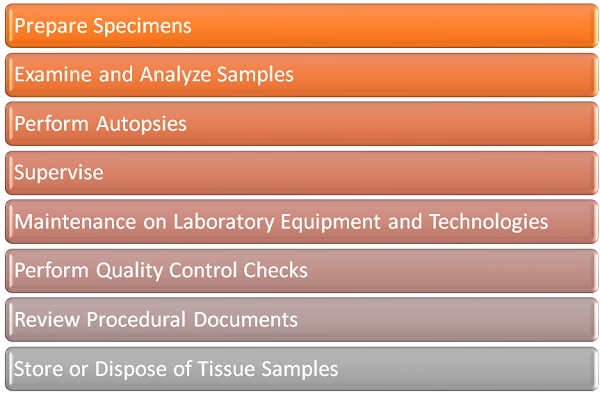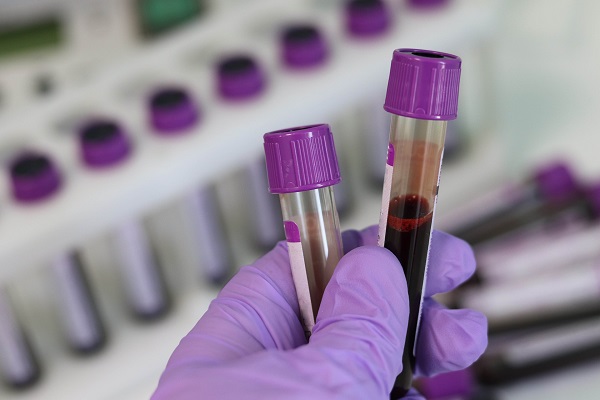To become a pathologists’ assistant, you need one of the highest paying master’s degrees: a master’s in pathology. In this role, you would perform an array of job duties that support the work of a pathologist, a medical doctor – with an M.D. or a D.O. – who focuses on the causes and effects of disease. Some of the primary job duties you would perform in this clinical laboratory role would include preparing samples of tissues and cells for analysis, examining those samples under a microscope and, in certain roles, conducting post mortem examinations on dead bodies.
Prepare Specimens
Many of the medical tests patients undergo involve retrieving samples of body tissues, fluids or cells. Whether as part of routine bloodwork or a biopsy of a suspicious mass, these exams yield specimens that must be examined to diagnose a medical condition or to assess the damage caused by a known disease.
IMAGE SOURCE: Pixabay, public domain
Before those examinations can take place, someone must carefully process and prepare those specimens. For example, if the specimen is to be examined under a microscope, it must be put into a slide. In some instances, specimens must be dyed, which can require the use of different types of staining techniques. It’s a pathologists’ assistant’s job to prepare samples correctly and submit them for analysis.
The process of preparing samples for examination in a pathology lab can be a lengthy one. The first step is usually preserving the specimen. Other common steps in the process of preparing a specimen for laboratory analysis include dehydrating it, embedding it in paraffin to make it more solid and slicing it into sections thin enough to be mounted onto microscope slides.
Some specimens must also be frozen or decalcified as part of processing.
Examine and Analyze Samples
It isn’t the pathologists’ assistant’s job to come to a diagnosis or decide how to go about treating patients. That role belongs to the pathologist, who is a medical doctor, along with the patient’s own provider. However, examining and analyzing specimens is a part of the pathologists’ assistant’s job, although the degree to which the assistant is responsible for analysis depends on workplace policies and legal regulations.
Often, the pathologists’ assistant is the first person to perform any examination or analysis of the sample. Long before specimens end up mounted on microscope slides, the pathologist’s assistant receives the sample in its original form – which may include a surgically removed organ or body part – and begins to undertake what’s called a “gross examination.” In the gross examination stage, the pathologists’ assistant describes and photographs the whole sample prior to beginning dissection, processing and sectioning.
To facilitate this crucial job duty, pathologists’ assistants complete coursework in graduate school on both medical terminology and medical photography.
Perform Autopsies
Another job duty pathologists’ assistants do – especially those working in the discipline of anatomic pathology – is assist with autopsies. Autopsies are the post mortem medical examinations performed on bodies when the cause of death is unclear. Not all pathologists’ assistants work on autopsies in the course of their career, but master’s degrees in pathology typically include both coursework and clinical rotations that require students to assist with autopsies. Helping a pathologist or medical examiner conduct autopsies might be part of your job description if you work in an anatomic pathology laboratory or an autopsy suite at a hospital or in a medical examiner’s office, morgue or forensic laboratory.
Some tasks a pathologists’ assistant may perform in the context of an autopsy, according to the American Association of Pathologists’ Assistants, include examining the external appearance of the body and the organs inside it and removing body parts to be tested.
What Else You Will Do as a Pathologists’ Assistant
Beyond the laboratory work of preparing and examining samples and helping conduct autopsies, pathologists’ assistants perform other job duties. Sometimes they supervise laboratory technicians, aides, assistants and other professionals who have less education and formal training. They may have job duties that involve the maintenance, validation and assessment of new or existing laboratory equipment and technologies. To ensure that results are accurate and precise, pathologists’ assistants are sometimes required to perform quality control checks, write or review procedural documents and store or dispose of tissue samples properly in accordance with legal regulations and hospital policies.
Some pathologists’ assistants go on to become laboratory managers, overseeing the operations of the medical laboratory and its staff. A pathologist cannot become a physician, because a pathology degree is not the same as a medical degree (an M.D. or a D.O.).
Additional Resources
Do I Need a Certificate to Become a Pathologists’ Assistant?
Why Would I Want to Become a Pathologists’ Assistant Instead of a Pathologist?
What Does Studying Pathology Mean?


